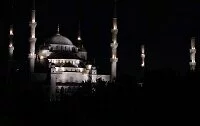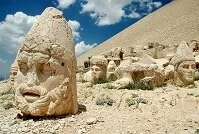After the Seljuk Turks came the Ottoman Turks, who truly altered the architectural landscape in the country as a whole. Although a number of Turkish baths and caravansaries were built by the Ottomans, their most magnificent monuments are mosques and kulliyes (the area surrounding mosques, often including baths, schools, and more). The city of Safranbolu is almost entirely built in this style, including their mosques, bath houses, caravanserai, and more. In the city of Edirne, the Selimiye Mosque (1522) is one of the more impressive mosques in this style.

Blue Mosque
The peak of Ottoman architecture though, like Byzantine architecture before it, was focused on Istanbul, which the Ottomans took in the 1400s. These monuments begin with the Fatih Mosque (1463-1470) and the Sultans' residence, Topkapi Palace (first stage completed in 1465). From here though, the empire covered Istanbul with numerous mosques, kulliyes, bazaars, and bath houses, including Bayezid Mosque (1400-1500s), Suleymaniye Mosque (1500s), Sultan Ahmed Mosque (Blue Mosque; 1609-1616), the New Mosque (Yeni Camii; 1597-1663), the Grand Bazaar (1455-1461), and later the Cagaloglu Bath House (Hamam; 1741).

Mt. Nemrut
In the 1700s the architectural style in the Turkish empire was influenced by Europe as a distinct form of Baroque entered the country. The Nuruosmaniye Mosque (1749-1755) is perhaps the finest example in this style.
Since the 1700s, the Turkish empires have been in decline until relatively recently, meaning little new notable architecture has been constructed. Since the Turkish Revolution in 1923, the capital was moved to Ankara and both the new and old capital began building in a more modern style and design, leading to a modern skyline in Ankara and parts of Istanbul that have the same.